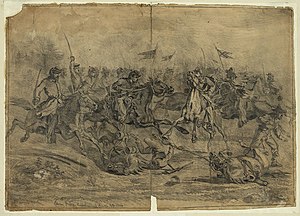Battle of Brandy Station
| Battle of Brandy Station | |||||||
|---|---|---|---|---|---|---|---|
| Part of the American Civil War | |||||||
 "Cavalry Charge Near Brandy Station" by Edwin Forbes |
|||||||
|
|||||||
| Belligerents | |||||||
|
|
|
||||||
| Commanders and leaders | |||||||
| Alfred Pleasonton | J.E.B. Stuart | ||||||
| Strength | |||||||
| 11,000 | 9,500 | ||||||
| Casualties and losses | |||||||
|
907 total (69 killed 352 wounded 486 missing/captured) |
523 total | ||||||
Inconclusive
The Battle of Brandy Station, also called the Battle of Fleetwood Hill, was the largest predominantly cavalry engagement of the American Civil War, as well as the largest ever to take place on American soil. It was fought on June 9, 1863, around Brandy Station, Virginia, at the beginning of the Gettysburg Campaign by the Union cavalry under Maj. Gen. Alfred Pleasonton against Maj. Gen. J.E.B. Stuart's Confederate cavalry.
Pleasonton launched a surprise dawn attack on Stuart's cavalry at Brandy Station. After an all-day fight in which fortunes changed repeatedly, the Federals retired without discovering Gen. Robert E. Lee's infantry camped near Culpeper. This battle marked the end of the Confederate cavalry's dominance in the East. From this point in the war, the Federal cavalry gained strength and confidence.
The Confederate Army of Northern Virginia streamed into Culpeper County, Virginia, after its victory at Chancellorsville in May 1863. Under the leadership of Gen. Robert E. Lee, the troops massed around Culpeper preparing to carry the war north into Pennsylvania. The Confederate Army was suffering from hunger and their equipment was poor. Lee was determined to strike north to capture horses, equipment, and food for his men. His army could also threaten Philadelphia, Baltimore, and Washington, and encourage the growing peace movement in the North. By June 5, two infantry corps under Lt. Gens. James Longstreet and Richard S. Ewell were camped in and around Culpeper. Six miles northeast of Culpeper, holding the line of the Rappahannock River, Stuart bivouacked his cavalry troopers, screening the Confederate Army against surprise by the enemy.
...
Wikipedia
